
Home
Me and my Family
Site Map
New/Updated Pages
Contact Me
Riding Journal
About Me
Riding History:
When I was a lad living in the rural Waikato village of Springdale, my father had an old Suzuki RV90 and occasionally he would take my brother and me to school on it - riding along the near-deserted country roads with me on the back and my brother in front of him, none of us with any helmets.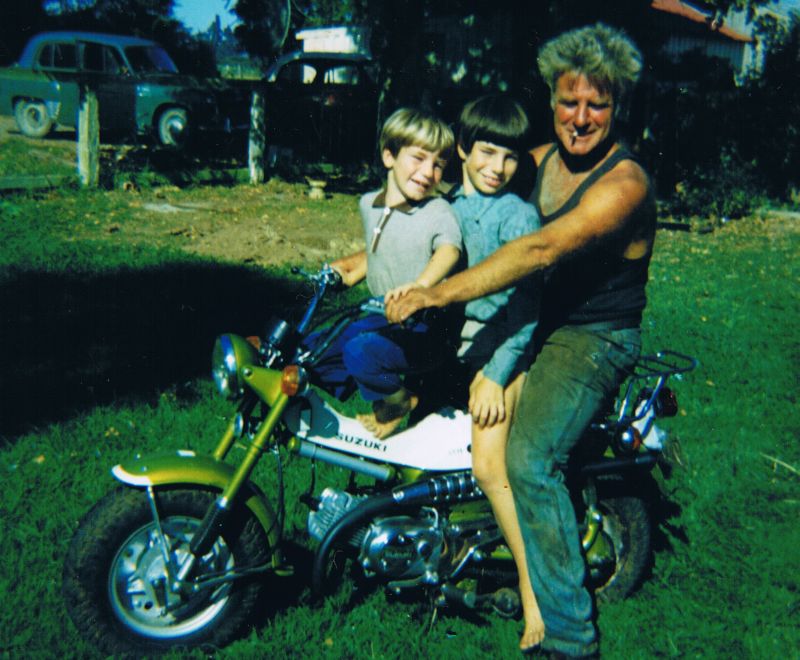
From left to right: My brother (Michael), me and dad on the RV90. When going to school I usually sat on the tail rack.
My own riding experience began when I was somewhere between 8 and 10 years old, riding that same Suzuki RV90 around the paddocks of the farm we lived on.
I have clear memories of opening the throttle too suddenly and having the bike take off abruptly, which caused me to slide back on the seat - which in turn caused me to pull on the throttle and open it right out. I couldn't pull myself forward against the bike's acceleration and I didn't dare loosen my grip on the throttle so I shot across the paddock at full acceleration until the bike stopped accelerating. I could see the fence on the far side of the paddock was approaching fast and I was scared I was going to run out of paddock before the bike ran out of acceleration. Fortunately the bike's speed levelled off in time and I was able to pull myself forward on the seat, close the throttle and bring the bike to a stop before I got to the fence. Only just before...
Sadly, the bike eventually died and dad never got a replacement but I did ride other people's farm bikes from time to time over the years.
And that was pretty much it until 1982 when I was 18 years old, in University and in need of transport of my own as some of my courses were at night after the laughable bus "service" had gone to bed.
I had never really been interested in cars so I decided on getting my motorbike licence.
A large part of my decision to get a motorcycle was the time I spent in Tahiti travelling all over the place on the back of a Piaggio Vespa scooter ridden by my host, Daniel. I enjoyed it so much that, when the question of transport arose, a motorcycle was foremost in my mind.
Of course, I had no money to purchase a bike and no credit history so my dad actually went and purchased a brand new Yamaha RX125 for me to learn on - well, he paid the deposit and signed the necessary paperwork and it was up to me to keep up the payments.
In those days, getting a learner's motorcycle licence was a matter of studying the Road Code, sitting a 35-question written test on general road rules and answering 5 oral questions that tended to be on rules pertaining to the class of vehicle you were getting the licence for. As simple as that - no "Basic Handling Test", just a few questions and then unleashed on an unsuspecting public - "Licensed to Kill or Be Killed."
I passed the written and oral tests, got my nice shiny and new licence book and I was allowed to practise riding on the road, subject to a few restrictions - no faster than 70km/h, no pillion passengers, engine displacement no more than 250cc. We never had "L" plates but we did have a different coloured registration sticker than that of fully licensed riders.
That was me sorted for transport. I had discovered the joys of motorcycling and I was hooked for life.
After a suitable period had elapsed, I was entitled to go for a practical riding test and attempt to get my "Provisional Licence" - akin to today's "Restricted Licence". The riding test entailed following a policeman on his bike around town and then stopping in a narrow side street to perform a figure-eight without putting a foot on the ground and later doing a hill start - "Basic Handling" and Driving Test all in one! If you obeyed the road rules, seemed alert, managed the manoeuvres and seem competent, you got your Provisional Licence.
Although I had the RX125 at this stage, I did not feel confident attempting to perform a figure-eight on it so I borrowed a friend's 50cc automatic-transmission scooter and went for my licence on that. I passed the test and was given my Provisional Licence and was entitled to ride my larger, more powerful, manual-transmission RX125 with fewer restrictions than before.
After a year of riding around on my Provisional Licence, I automatically qualified for a Full Licence. By this time I had already fallen off the RX at least twice.
Finances dictated that I could not upgrade to a larger bike so I rode the RX for a while and, when I got a part time job, bought my Suzuki TS125.
I still wanted a "big bike" even though I had the TS125 and when I was working at the Vistec Film Processing lab on Sloper Ave I wound up buying a wreck of a Yamaha RD350 that a more experienced rider later tried and promptly informed me the frame was twisted and I was bloody fool riding it. But I rode it anyway.
Car licence:
I did not get my car licence until I after I turned 34. I had no need of a car licence - I had transport with which I was more than happy, I had all the licences I needed and the only person who wanted me to get a car licence - for which I would have to pay - was my boss, who wanted me to be able to drive a company car from time to time.We argued it out for a couple of years; my contention being that I was quite satisfied with the status quo, I had never before required a car licence in my job and if my work was to change to the extent that I needed one, the onus was upon my employer to meet the costs as "Professional Development". My boss contended that most jobs require a full car licence so I would be increasing my value.
In the end I quit arguing and went for my car licence. I could drive a car - having driven before under the somewhat more liberal laws they had back then - so I only had to get a learner's licence, familiarise myself with my girlfriend's car and go for my driving test.
The graduated car licences had just come in for new drivers, but because I was over 25 I was entitled to skip the Restricted Licence and just do the 5 car-related oral questions to get my Learner Licence then pass a driving test to get my Full Licence.
Having a car licence is handy and owning a car is very convenient with three children under five years of age to cart around, but I never get the same level of enjoyment out of driving a car that I do from riding a motorcycle. I do not drive a car "just for the sheer fun of it" (as I often ride my motorcycle), because to me a car is merely a means of getting from one place to another.
Other interests:
Rifle shooting:On most of the farms where I grew up, there was at least one firearm - usually a .22 calibre, for small-game hunting and pest destruction, or the ubiquitous ex-WWII .303 calibre Short Magazine Lee Enfield (usually "sporterised" by having most of the wood cut away) for deer hunting. I was taught firearms safety from an early age and learned to shoot under the direct guidance of either or both of my parents - both excellent shots.
As a teen, I decided I wanted a firearm of my own and set about getting myself licensed.
I sat and passed the firearms safety exam three times.
The first two times were under the old "Permit to Procure" system where you passed your test and were given a time-limited permit that entitled you to buy a firearm which then had to be registered with the police. Both times, by the time my application had been processed and I had sat and passed the test, I had run out of money to actually buy a firearm and I was forced to let the permits lapse unused.
I first went for a Permit to Procure at the tender age of 18 and my mother had to sign a form declaring she was OK with me owning a firearm.
I rocked up to the Arms Officer at the Hamilton Police Station with my completed application and parental permission forms and the officer regarded me as if I was some species of vermin.
"Why do you want a firearm?" He asked brusquely.
"Target shooting, a bit of rabbit hunting out on my uncle's farm, that sort of thing," I replied.
He looked at the forms and sternly informed me he was going to call my mother. He then spent a lengthy time on the phone mainly saying "Uh huh" and "Yes" and "that's quite right" at various intervals, so I gathered he was getting the "my son knows that when he enters the house with a rifle it had better be with the rifle in one hand, the bolt in the other and the ammo in his pocket or I'll punch him out the door" speech that I had had drilled into me ever since I was a young-un.
He finally hung up, turned to me with a smile and was very nice while he processed my form and gave me my appointment for the next firearms safety course. I'm not sure if this was because he had been reassured that I was not the average young idiot who wanted a rifle or because he felt sympathy for me. He was also very pleasant when I turned up with the pass chit from the instructor to pick up my Permit to Procure.
The third and final time I sat the exam was prior to my 20th birthday after the introduction of the new "Lifetime Licence" in 1983. Under this new system, the owner, rather than the firearm, was registered so there was no need for individual permits to procure.
Even though I was broke and could not actually afford a firearm, I figured that if I got the new licence as soon as possible I would have it on hand when I did have the money - rather than risk spending all my dough while going through the legal process of getting a licence.
I sat and passed the new firearms safety test, based on seven safety rules rather than the original five, and was eventually issued with my new "Category A" (rifles and shotguns) Lifetime Licence - a book similar to the vehicle licence books but with a red cover rather than deep green.
With typical irony, I got a sudden windfall not long later and was able to afford my first rifle - a single-shot bolt-action .22 calibre Gecado.
In 1992 the Arms Act was amended again and the "Lifetime Licences" were replaced by a 10-year plastic card with photo - long before photo ID cards were introduced for vehicle licences.
Over the years I have owned:
.22lr Gecado single-shot bolt-action
.22lr Anshutz 16-shot semi-automatic
.243 Miroku lever-action (Japanese-made Browning)
7.62x54R Mosin-Nagant 5-shot bolt-action rifle (not the carbine version)
.22lr BSA Martini-Action heavy-barrelled target rifle
.22lr Brno ZKM-451 10-shot bolt-action - stolen and never recovered (but the thieves didn't find the bolt)
7.62x39mm SKS 10-shot semi-automatic - the magazine was later cut down to 5 shots due to the Arms Act 1992.
.22lr Brno ZKM-451 "Luxus" 10-shot bolt action (to replace the one that was stolen)
... as well as a couple of .177 calibre air rifles and four .177 calibre air pistols for which I did not require a licence.
All of the firearms except the two Brnos were bought second hand and came to me in "less than pristine" condition - in fact, the Miroku looked as if it had seen service as a cricket bat, if the dents in the stock were any indication.
I turned "amateur gunsmith" and learned how to restore them: how to apply and cure bluing solution and how to strip the varnish and get the dents out of the wood. I spent many satisfying hours labouring over smelly chemicals or waving the wooden bits over a boiling jug to steam out the dents and then rubbing copious quantities of linseed oil and bee's wax into the stock. There were times when the house smelled of nothing but gun-blue, gun oil and linseed.
The Gecado, Anshutz (for which I had to purchase a new receiver as the old one had cracked dangerously), Miroku and BSA all left me in far better condition than they came to me - gleaming blued metal and shining oiled wooden "furniture" - and I sold them for more than I paid for them. The Miroku had gone from wreck to nearly brand new condition.
Camping:
I've been an avid tramper and camper for many years. I first "got the bug" when I went to school camp at Port Waikato where we were taught how to pitch a tent properly, make a fire and cook our own dinner - I would have been around 11.
I joined the Scouts but our troop was badly run and our leaders' idea of a camp was to pitch a tent in the paddock of someone's farm (which meant they could freight in a lot of useless crap by car with little difficulty) and I learned mainly how to set up large trestle tables and put stupid fences around the tents.
I ended up quitting the Scouts and didn't go camping again until was in my late teens when I could afford to buy my own gear.
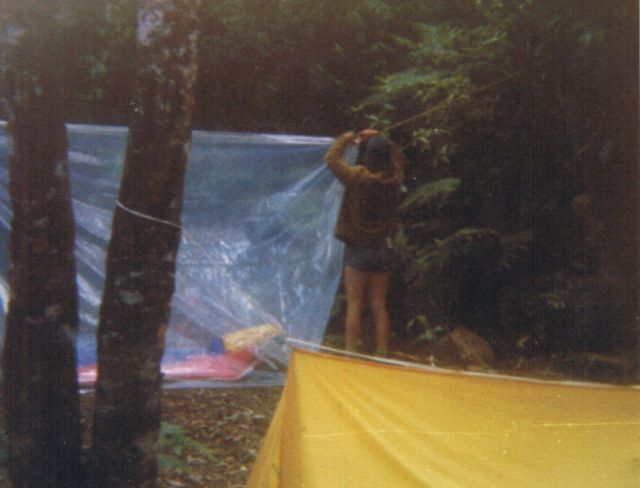
First time going it "alone" (without the Scouts - of course I had buddies with me). A borrowed A-frame tent (foreground) and a makeshift tent made from a very large plastic bag (a fellow camper, Stuart, is fastening it).
My early equipment was very basic - a cheap A-frame tent without a fly, a summer-weight sleeping bag I bought as a cheap "Factory Second" at David's Emporium (the only fault was that lines of stitching that were supposed to be parallel crossed over each other - not a real problem but enough to consign it to the cheap bin), some cheap enamel plates, a billy, whatever clothes were warm, and a second-hand pack.
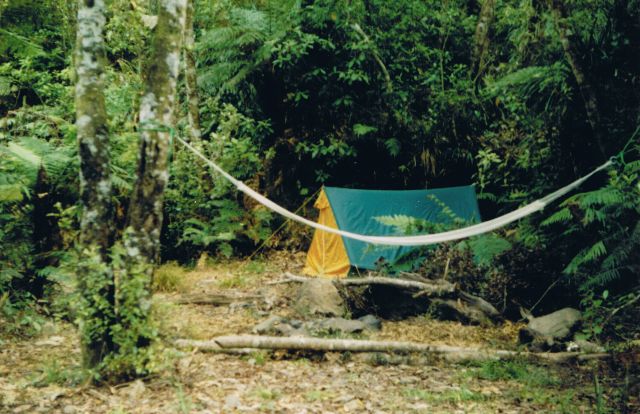
My own A-frame and a nylon hammock - all the comforts of home.
Over time I refined my equipment, mostly purchased from the Army surplus store with the occasional bit of purpose-made camping gear thrown in for good measure. I went through various boots, clothes and equipment over the years seeking the best combination to suit my needs.
I progressed from warm clothes selected from my daily wardrobe to having dedicated camping clothes - at first warm and durable (but bulky) Army-surplus stuff and then later modern synthetic thermal wear. My footwear went from cheap sneakers through Army-surplus boots and various heavy tramping boots to lighter sneaker-like hiking shoes.
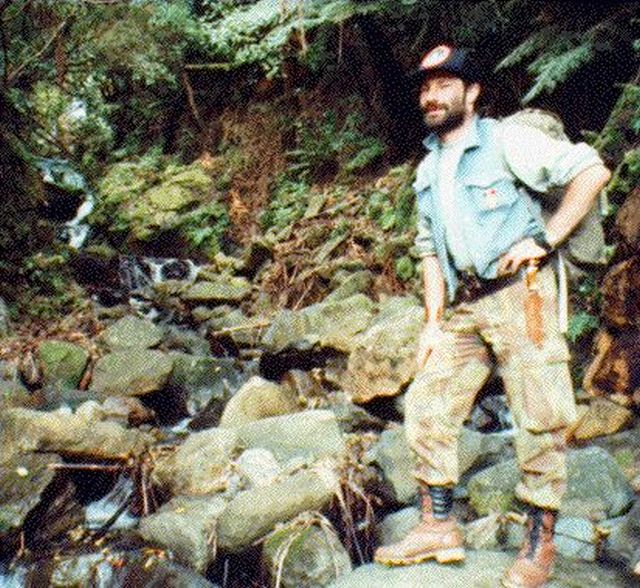
One of the earlier combinations: army surplus pack and heavy tramping boots. Still wearing cotton shirts at this stage - hadn't yet discovered polypropylene.
I found toiling up mountain trails and leaping from rock to rock with an 80-litre pack - crammed to capacity with clothes, food, camping gear and all sorts of useless garbage - and then lugging most of it back again to be needlessly tiring. I went all out on trying to lighten the load and eventually progressed to a 45-litre pack containing only what experience told me I really needed.
With the introduction of new synthetics such as polypropylene and Thinsulate, I decreased the bulk and weight of my clothing further and I purchased a smaller and lighter tent.
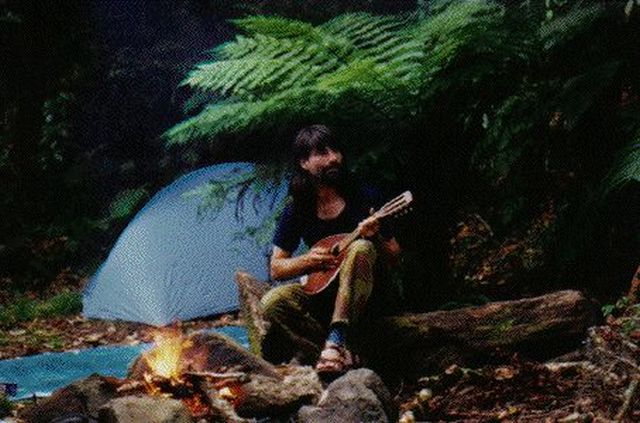
A bit more sophisticated: polypropylene undershirt worn as a T-shirt, polypropylene leggings under the trousers and a one-person "dome" tent. Had lightened the load enough I could even lug my mandolin up the trail.
Food was still an issue and I was finding myself lugging lots uneaten food back down the trail again. I managed to score a couple of black-market Army-issue "Rat Packs" (ration packs) and I figured that if anyone knew how much food an adult required for a day whilst engaged in exercise, the Army would.
I tried out a rat pack on an overnight camp and took note of what I actually used and what I didn't. I thereafter based the food I carried (and the quantity) on that - with a few modifications: the rat packs I got had far too many tins of food for my liking (the army might be sadistic enough to expect its soldiers to lug unnecessary weight around but I'm neither a soldier nor a masochist) so I replaced most of the tinned food with an equivalent amount of lightweight dehydrated camping food. The sole exception was the small tin of pineapples - they were just too good to leave out.
Lightening my camping gear and learning to only pack the necessities have stood me in good stead with my motorcycle touring where bulk, rather than weight, is the main issue. When I went to the Cold Kiwi Rally I had my 45-litre pack (filled mostly with my -10 degree sleeping bag), my tent, a sleeping roll and my Army-surplus dixie and canteen bungee-strapped to the back of my little XT225. The only stuff I needed that I was not carrying was a gas cooker and a torch (I couldn't find the former and the kids had flattened the batteries in the latter) - both of which I could have easily fitted on the bike.
Today my camping gear is a weird mixture of Army surplus (canvas belt bag in which I carry my survival gear, US Army canteen and dixie with belt pouch) and modern camping gear (polypropylene thermal wear, light and flexible hiking shoes, lightweight 45-litre Nylon pack, sleeping bag and single hoop tent) and very minimalist - my dixie serves as both the cooking and eating vessel.
One thing that I always carry is a small (Army surplus) belt pouch containing survival gear: pocket knife, compass, magnifying glass, waterproof matches, strips of rubber (better and cheaper than commercial fire lighters as you can just wipe them dry and light them), large plastic rubbish bags (makeshift shelter, "sleeping bag"or rain wear), reflective Mylar survival blanket, basic first aid kit, dry socks, polypropylene balaclava and gloves, nylon wind-cheater (light, unlined, folds into its own pocket) and a small commercial survival kit around the size of a car's puncture repair kit (contains fishing line and hooks, whistle, signal mirror, Potassium Permanganate for purifying water, scalpel blade, waterproof matches and a few other survival items).
On the same belt I carry my large bush knife and my US-Army-surplus canteen-and-dixie combo. If I leave the camp-site even for a brief walk or to get firewood, I have the basics of survival on me. The heaviest item is the 1-quart canteen full of water so it's not a major load to carry.
Things I've learned the hard way:
Cotton T-shirts get soaked in sweat and the slightest breeze is quite chilling. They also can take hours to dry. I now wear polypropylene T-shirts - technically thermal underwear - instead, as they wick the moisture away from my skin to evaporate on the outside of the garment (cooling, not chilling) and they dry quickly.
Rigid soles and soles with a metal reinforcing rod are dangerous on rocks as you only have a small contact area on the curved surface of the rock. I now wear shoes with supple soles so that my feet can curve over the rocks and provide better contact. Bare feet are superior to most so-called "tramping boots" in rocky terrain.
Take especial care clearing your fire site as water-logged porous rocks buried a few centimetres below the fire can create a spectacular crater and throw hot wood and rocks a considerable distance. (Also pays not to wander around the camp-site in bare feet.)
Wet tramping boots/shoes are a pain to get into when waking up to a "nature call". I now carry lightweight "boat shoes" or sandals that are easy to slip on - to wear around the camp-site.
Never go camping with someone who has been hospitalised with stomach ulcer problems in the hope that the natural surroundings will help them de-stress - all that happens is they take extra effort to turn a normally tranquil surrounding into something more stressful than the rat race...
Never go camping without a buddy, even if you know the area well. Unforeseen things can happen that could potentially leave you stranded with no means of summoning help. I was lucky enough to have narrowly missed disaster.